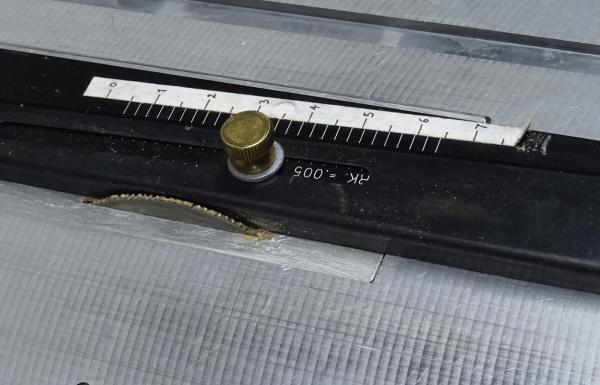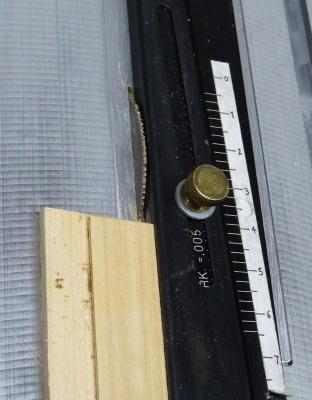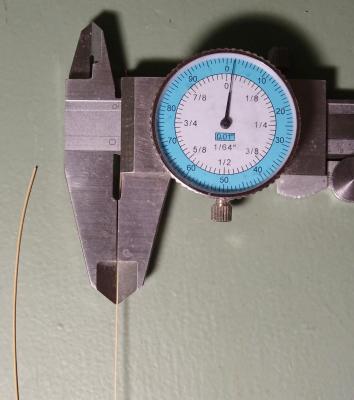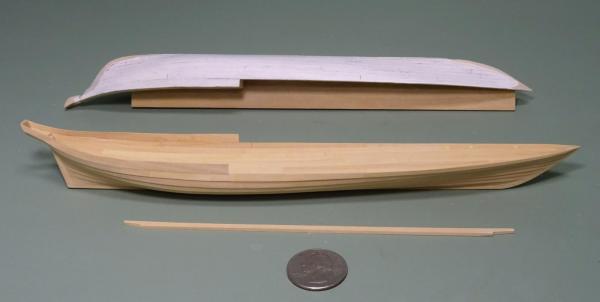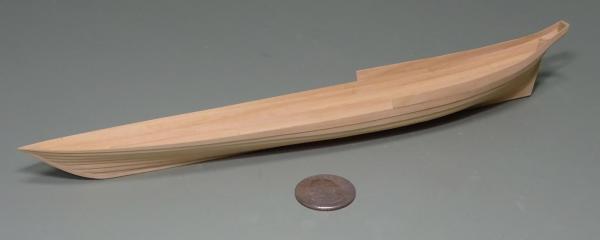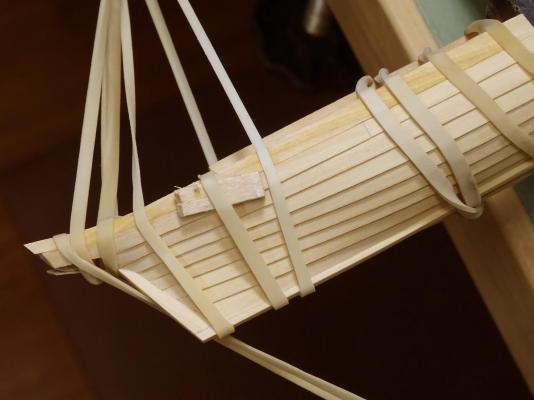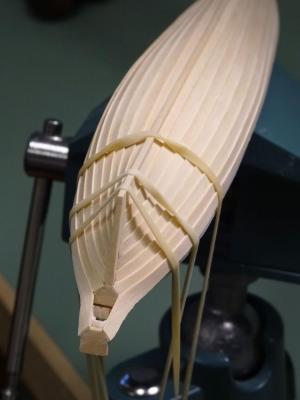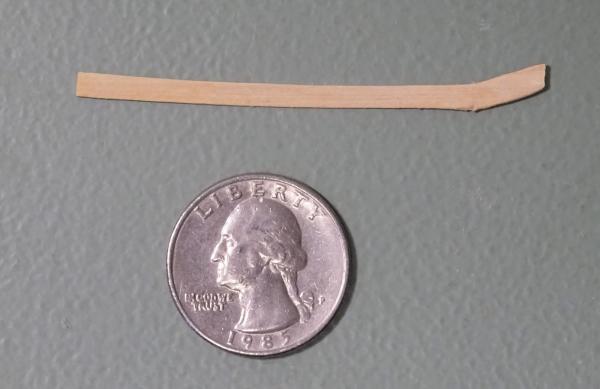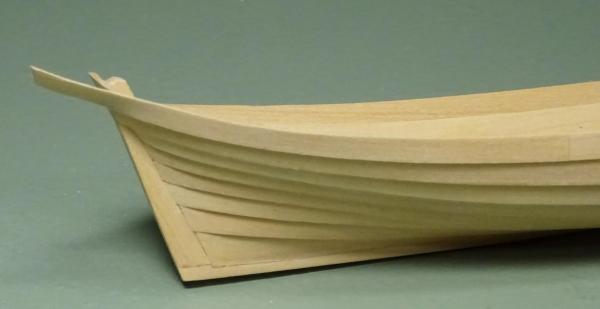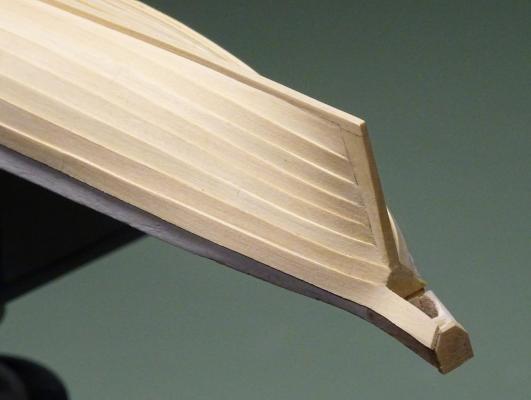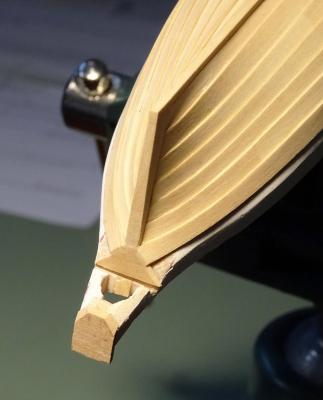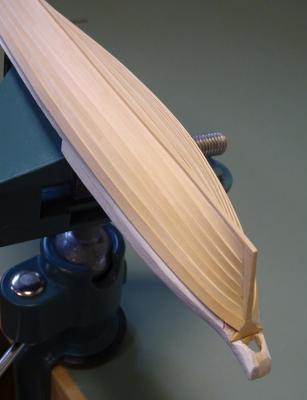-
Posts
13,168 -
Joined
-
Last visited
Content Type
Profiles
Forums
Gallery
Events
Everything posted by druxey
-
For some reason I missed seeing this thread until this morning. Fascinating research and interpretation, Woodrat! You are doing a terrific job in these rather poorly charted waters.
-
Next is to cut stock a scale ¾" square. This is next to impossible without a zero-clearance table and a slitting saw blade. So I made an insert of aluminum sheet and raised the saw blade through this, as shown (upper left). Note that, on this saw, I have an Accuriser II fence. I attached a secondary scale measuring in inches at 1/48 scale. This avoids having to translate from thousandths of an inch (actual) to scale inches. I cut several sheets of 1/64" Castello stock and rubber cemented them to a sacrificial piece of softwood. In this case it was simply a paint stir-stick (upper right). This was then run through the saw and the pieces separated and cleaned up, giving the 1/64" square section required for the frames (below).
- 641 replies
-
- greenwich hospital
- barge
-
(and 1 more)
Tagged with:
-
Thanks, Michael. I use white PVA, slightly thinned, applied with a small watercolour brush. The outside is washed down with a damp brush immediately, and the inside is cleaned up afterwards with a dental elevator (looks like a bent mini-chisel). If there is a stubborn bit of glue, a drop of water on a brush does the trick. Should a little of the joint give way, I run more dilute glue into the crack and clamp it shut with one or more of those mini-clips. This rarely happens, as the bevelled land creates a tight joint.
- 641 replies
-
- greenwich hospital
- barge
-
(and 1 more)
Tagged with:
-
Yes, more or less. There is a photo of this area of Victory that show these T-straps in place. It is shown in Longridge's Anatomy of Nelson's Ships, Plate 19, opposite page 100. I can't post this photo as it may infringe copyright. Hopefully you have access to a copy if you don't already own one. (You should!)
-
Well, good health to you both, and to all readers of this log!
- 745 replies
-
- francis pritt
- mission ship
-
(and 1 more)
Tagged with:
-
Thanks again, everyone, for looking in and your comments. David B: I'm not sure what your question means. Which 'other half' are you referring to?
- 641 replies
-
- greenwich hospital
- barge
-
(and 1 more)
Tagged with:
-
Finally the shell has been completed. It is quite delicate right now, as the last half strake is only edge-glued to the strake below. However, the pink stern is quite strong, even at this stage. Next will be installing the keelson, followed by bending in the frames. The plug, as you can see, has been beaten up quite a bit in the process of planking.
- 641 replies
-
- greenwich hospital
- barge
-
(and 1 more)
Tagged with:
-
Thanks again for the likes and comments, everyone. And yes, Ed, I too am mortal! The sequence of construction needs to be carefully considered. Before adding the keelson (making replacement on the plug impossible) a last half-strake needed to be cut and fitted. This will carry all the ornamental scrollwork aft. It has a sinuous S-curve in plan, and required the entire elastic band brigade to damp-shape it into position.
- 641 replies
-
- greenwich hospital
- barge
-
(and 1 more)
Tagged with:
-
The sheer strake proved challenging in more ways than I had anticipated. First, this strake tapers to a point at the bow. Finessing this was not easy. Secondly, I had a minor mishap. While working with the hull off the plug, my sleeve caught the unsupported aft end of the strake and it snapped off. So, a re-do. I flattened and re-assembled the broken plank to show its peculiar shape. Wes mentioned a U.S. quarter, so I've included one for scale. I will not remove the shell from the plug again until both sides of the aft ends are complete and united with the outer transom!
- 641 replies
-
- greenwich hospital
- barge
-
(and 1 more)
Tagged with:
-
Well, a challenge it has certainly been. The aftermost plank of the sheer strake is unlike any plank I've hung before. The pictures describe this plank better far than I can write about it. There was a lot of shaping required to get this plank to lay down properly. One can now see the beautiful sweep of the sheer properly. Now all I have to do is repeat this on the other side!
- 641 replies
-
- greenwich hospital
- barge
-
(and 1 more)
Tagged with:
-
Thanks again for your interest and comments, folks. I realized that the second strake of planking (the sheer strake) at the mini-transom does not stop there, but sweeps aft to a secondary transom (I don't know what else to call it). So I had to trim back the end of the plug by a scale 1½" and rubber-cement this second transom to it. Eventually it will be hidden under an ornamental carved badge. The plank here will have an interesting dog-leg shape and need some fancy bending to fit properly. That's my next challenge! GHB rev lines.pdf
- 641 replies
-
- greenwich hospital
- barge
-
(and 1 more)
Tagged with:
-

molding casting metal
druxey replied to michael101's topic in Metal Work, Soldering and Metal Fittings
I agree with Clare - stay away from lead-bearing pewter. I pour pewter in Micro-Mark's 1:1 RTV moulds with no problem. -
The red paint on the cutaway makes it clear that it is, in fact, a cutaway. I think your idea of doing this a good one, Dan.
- 268 replies
-
Thank you all for your kind comments, gentlemen. The compliments should really go to the original designers of these craft.
- 641 replies
-
- greenwich hospital
- barge
-
(and 1 more)
Tagged with:
-
I wonder if the builders of the original flywheels had the same issues with the castings. You certainly had a challenge keeping 16 pieces under control! However, the end result looks terrific. I hope the other three wheels are less hassle for you.
-
Time for a progress report. The planking has slowly been spiled, cut, bent and hung as far as below the sheer strake. The first picture (arrowed) demonstrates the bevel for the land of the next strake. This was formed using the sanding stick mentioned earlier. Note that the bevel alters - and disappears - as the hull form changes. The second photo shows the transition of the strakes at the stern from hooding into the stern post rabbet to running out over the tiny transom. Only two strakes end on the transom. Forming the junction of these two strakes neatly was tricky. The last photograph shows off the elegance of the hull form. At this stage I bevelled the stem so that the planking appears to flow out of it. After the sheer strake is added there will be clean-up and minor adjustments to make.
- 641 replies
-
- greenwich hospital
- barge
-
(and 1 more)
Tagged with:
-
Just discovered your log, Matti. Rigging gets easier the more you do it. First time is always a stress test! Very nice work; one wouldn't know it was your first ship model. As for your next model, there are a lot of possibilities. First, what kind of ship appeals to you: wood or metal? What time period? Then, how much room do you have and what scale do you like to work at? Answering these questions will narrow down the choices a bit.
-

Frégate d'18 par Sané , la Cornélie
druxey replied to JohnE's topic in CAD and 3D Modelling/Drafting Plans with Software
Better and better each time, John. If you are offering plans, I imagine 1:48 and 1:72 would be popular. For those with limited space, 1:96 as well? Apart from a general lines plan, folk might want profile (internal deck arrangements), lofted frames, and deck plans. The really ambitious will hope to see masts, spars and rigging plans as well, if you want to go there. -
Wood will move where it wants to go. Start with a really straight-grained piece from which to cut your keel. It will need to be pinned in some way to your plug. This will keep it straight until your garboard strakes are fitted to it, giving everything a 'T' section assembly that will help maintain straightness.
About us
Modelshipworld - Advancing Ship Modeling through Research
SSL Secured
Your security is important for us so this Website is SSL-Secured
NRG Mailing Address
Nautical Research Guild
237 South Lincoln Street
Westmont IL, 60559-1917
Model Ship World ® and the MSW logo are Registered Trademarks, and belong to the Nautical Research Guild (United States Patent and Trademark Office: No. 6,929,264 & No. 6,929,274, registered Dec. 20, 2022)
Helpful Links
About the NRG
If you enjoy building ship models that are historically accurate as well as beautiful, then The Nautical Research Guild (NRG) is just right for you.
The Guild is a non-profit educational organization whose mission is to “Advance Ship Modeling Through Research”. We provide support to our members in their efforts to raise the quality of their model ships.
The Nautical Research Guild has published our world-renowned quarterly magazine, The Nautical Research Journal, since 1955. The pages of the Journal are full of articles by accomplished ship modelers who show you how they create those exquisite details on their models, and by maritime historians who show you the correct details to build. The Journal is available in both print and digital editions. Go to the NRG web site (www.thenrg.org) to download a complimentary digital copy of the Journal. The NRG also publishes plan sets, books and compilations of back issues of the Journal and the former Ships in Scale and Model Ship Builder magazines.



